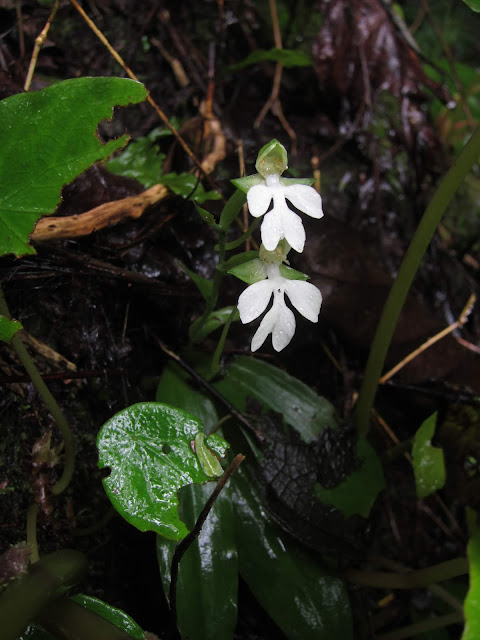A new geographical record for Habenaria rhodocheila subsp. philippinensis?
 | ||
| Habenaria rhodocheila subsp. philippinensis
Nov. 9- We were driving along a stretch of a road in the province of Laguna when we decided to check out a waterfall where one of my companions, Ronald, said held a population of Begonia tayabensis, one of the few peltate-leaved Begonia species found in the Philippines, a claim later proved true. This spot also supported some terrestrial orchids, notably the common and widespread Calanthe mcgregori and Geodorum densiflorum, as well as some Hetaeria oblongifolia and Zeuxine. But while photographing plants of the Begonia on a boulder, my eyes caught sight of a white-flowered Habenaria which I initially thought to be H. robinsonii, a species restricted to very few sites on Luzon, in the provinces of Laguna, Batangas, and Quezon. This taxon bear flowers with large, stark white labella and is a showier example in a genus dominated by more cryptic, green-colored blooms. However, I later realized that what we found wasn't this species, but something else. The only other Philippine species with a broad white labellum is H. rhodocheila subsp. philippinensis which is known from Mindanao. Indeed, it appears that these two similar species are geographically separated from one another, with the intervening islands of Visayas serving as a barrier. This discovery could be the first example of this subspecies to be found on Luzon.
How does one tell the two apart? The width of the leaves is a very good spot character. The leaves of H. robinsonii are narrow and grass-like, being only about a centimeter wide, often narrower. The foliage of H. rhodocheila subsp. philippinensis are much broader, and in one of the specimens located- the one in the photo below, the leaves were about 3.5 cm. wide; the broadest leaf of the flowering example illustrated above measured 2.7 cm. in breadth. Few other traits separate the two but in H. robinsonii the sepals are white (vs. green). Both taxa share the same ecological preferences, growing usually on rocks in fast-flowing small bodies of water such as creeks and streams, but H. robinsonii prefers lower altitudes not exceeding ca. 150 m., whereas H. rhodocheila subsp. philippinensis occurs at a wider altitudinal band from 60 to 1000 m. Our specimens were found at an elevation of about 350 m. We (Ernie Alvaran, who is also interested in species orchids, and I) found only three plants, but it is hoped that more individuals can be spotted once a more thorough search is undertaken.
Please also check https://philippineplants.org/Families/OrchidaceaeD-M.html to see photos of these two similar taxa.
P.S.
Do not expect the scientific community to take this report seriously, especially since the announcement was made very informally, on a blog. I would have written a more formal write-up in a reputable journal but I am still in my orchidology doldrums. Once these plants are detected by academe-produced botanists, then a more formal article may follow suit. Let's just let them take the credit.
|




Comments
Post a Comment